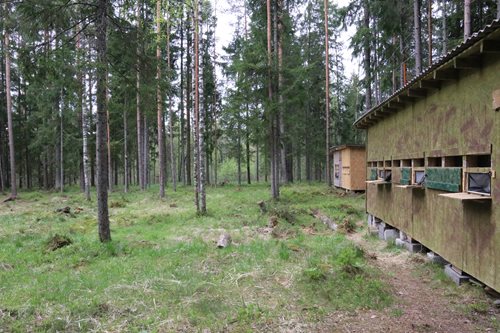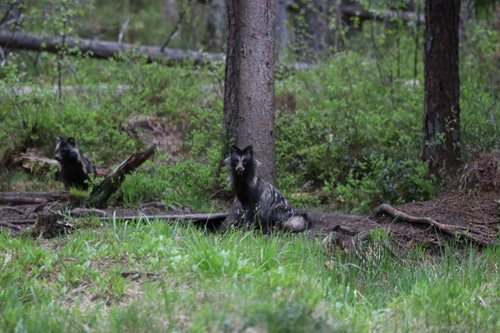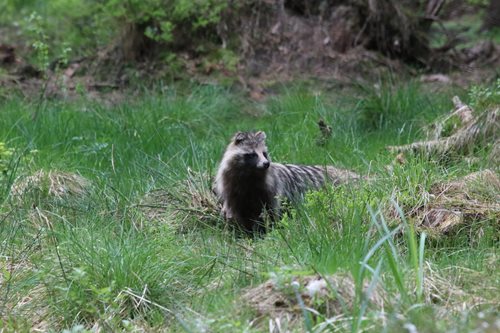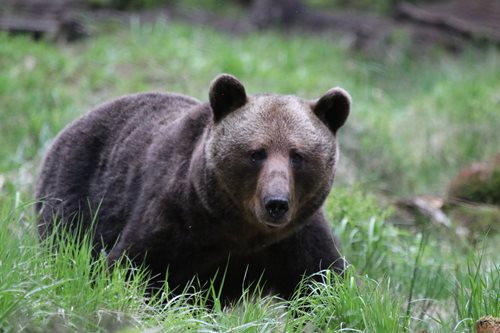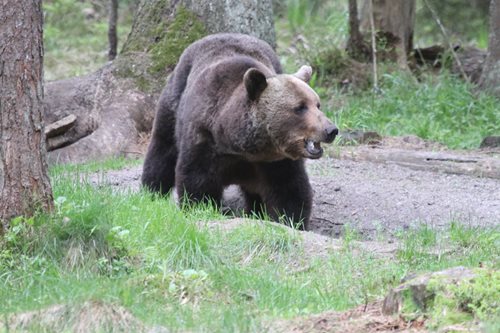Two white storks paused. They’d fussily been picking amongst the grasses and lifted their heads to check us out. As we tumbled from the car and pulled our backpacks and supplies for the night, they judged us as slightly distasteful and strutted slowly away on their back-to-front legs. (Why do their knees fold that way?) It was only 5pm but we needed to be settled in the hide well before creatures of the night become active. We walked a wide green forestry road between enormously tall silver birch and rustling Scots pine. And yes they did rustle: the upper bark had partially peeled away leaving translucent flappy pieces that moved in the wind. Flowers familiar from English woodlands and marshes were here but double or treble the size and made me think of Chernobyl across the border to the south-east. They were beautiful mutants if that’s what they were though: knee-high multi-petalled buttercups, violets and delicate wood anemones. In the drain along the side of the track where peaty water slowly flowed were enormous marsh marigolds and horsetails. Everything was so lush.
A sound I mistook at first for traffic noise was wind moving leaves in the lofty treetops. There was an array of other odd sounds I couldn’t identify.
I asked our guide about bear attacks. No there hadn’t been any deaths – that he’d heard of.
'If a bear comes at you,' he told us, 'there's no point in running – they’re fast. It is best to lie face down and keep still. Wearing a backpack helps protect you from the claws. Sometimes a bear will throw you about but you’ll probably survive if you play dead. Elk are more dangerous. Again there is no point running. They’ll come after you and trample you – especially if they have young. People don’t survive that.'
Our guide mentioned wolves too but seemed only really scared of vipers and ticks. Ticks give you a disease that kills you. He didn’t seem to be in the business of reassuring his clients.
Something let out a mocking cackle. I was on high alert as we tramped deeper into the forest moving from wooded meadows into forest dense enough to hide all manner of large mammals. The forest had fallen silent but I knew innumerable ears and eyes would be focussed on us. Only the trees themselves seemed to speak as they creaked and groaned and moaned and leaves stirred. Mosquitoes were audible – they looked like big mutants too and they were pleased to have us for dinner.
We entered the hide, tried to get all the rustling and banging over and settled down to look through slit windows, our camera poking through a lower slit, disguised by a black drawstring cloth. We waited, enjoying the antics of woodpeckers, nuthatches and chaffinches. Other birds twittered and small creatures moved on the forest floor. A hyperactive red squirrel bounced across in front of me.
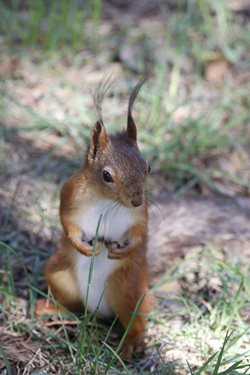
After about half an hour, my eyes were drawn to something larger – a squat shaggy creature with exuberant black whiskers trotted centre-stage and started scrabbling amongst the roots of a large tree. Dog-like, it cocked a back leg to urine-mark the spot. Another greyish racoon-dog joined the first and together they sniffed and dug, intent on unearthing something succulent. These creatures undoubtedly have the worst haircuts in the forest which is ironic since they are escapes from Russian fur farms. They originate in East Asia and are spreading through northern Europe and like American mink are unwelcome invaders.
They were fun to watch though especially after a second couple arrived and they were noisy squabbles over the best pickings. A shier animal appeared between the trees. This was sandy-coloured, long-legged and bushy tailed. Again this looked considerably larger than an English fox. There was a flash of orange and blue; a jay swooped down and flew off with a different titbit. The bait was doing its work but I began to wonder if anything would be left for the bears.
Then something different that moved between the trees caught my attention. It was large and dark. It came ever closer. The fox fled and so did the racoon-dogs. It moved making hardly a sound, ambling towards the tangle of roots that had so interested the racoon-dogs. Now this huge creature was in the clearing, I could see it was the correct light brown colour of a teddy bear and it had round teddy bear ears. Its eyes were small but its claws huge and it looked like most its 400kg was muscle. If it reared up on its back legs it would have been able to reach two-and-a-half metres with ease.
Saliva poured from its mouth and as it licked its lips I saw its teeth that looked like steak-knives. I was awestruck. It swatted aside a paving-stone-sized slab of rock as if it had been made of polystyrene. Some meat had been stashed underneath and the bear grabbed its prize and ran off with a bony joint in its mouth and drool pouring from its mouth. Again I was astonished at the effortless speed and quietness with which it moved through the forest. It was obvious how readily such a creature – and some weigh up to 600kg – could throw an adult human around like a doll. I was glad we were locked inside the hide. But then I was thinking that teaching bears to associate finding meaty bait with the smell of humans might not be the best approach to educating a powerful creature not known for its intellect.
The bear returned a while later and shambled around with all the swagger of one who knows he is top of the food chain. This time though I noticed a small bewhiskered face watching the bear unearth food, but all the while keeping a safe distance. This, the bravest of the racoon-dogs, looked understandably jittery but when the bear wandered away with a second joint of meat, the racoon-dog shot in and grabbed a bony piece for himself. These little opportunists don’t compete much with the bears: fast and feisty has its rewards and no doubt are hallmarks of a successful invasive species.
Estonia is flat boggy and green – half of the country is forested and is home to about 500 brown bears. This is more bears per square kilometre than any other European country but they are not easy to see. This is unsurprising as licences are granted for shooting them in some seasons. Bear meat is on offer in a few restaurants in Tallinn and bear pate is sold in some specialist food shops. Apparently it isn’t good eating.
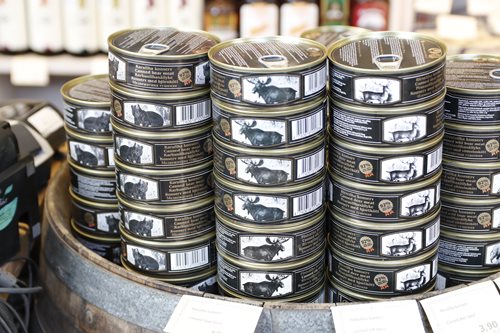
We spent ten days visiting several of the many reserves in Estonia and even in summer, when clouds tumble in and the wind gets up these seem like really wild places. The raised bogs, seemingly rising like dough out of the peat and myres, look particlarly desolate and lifeless and there are myths about how people disappear in the miasmas of the sphagnum marshes. When the sun shines though, Estonians bathe in the surprisingly deep peaty meres. The best reserve seems to be Sooma which is in the centre of the country and is described as four bogs separated by water. We walked for many kilometres on well-maintained boardwalks and saw evidence of some of large mammals but no more than poo and scratch-marks.
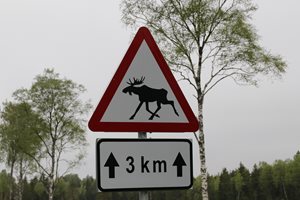
As we were starting our homeward journey we discussed whether Estonia might have more signs warning motorists about elk than there were elk in the country. Then on a long straight section of road we spotted in the distance a large horse by the roadside. As we approached we made out a rich chestnut brown animal and saw it was even larger than we’d first guessed as it creature was standing in the roadside ditch. It had the long face of a horse, but horse it was not. This was an elk – Americans call them moose – and with her was a single calf.
It was heartening to have been treated to good views of both of Estonia’s great creatures: proving that at least in this corner of Europe forests and their inhabitants are alive and well.
